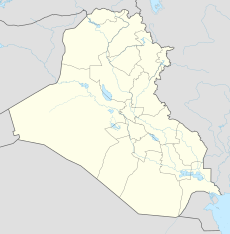Ninki
Iraq map |
Ninki, Nunki ( Sumerian D NIN.KI, NUN.KI; "Lord / in the earth / underworld") belong in the Sumerian religion to the original creation deities who could appear in individual and group form. Besides D NIN.KI existed from the präsargonischen to the ancient Babylonian and the designation time D NUN.KI.
background
Single gods
In Fara's large list of gods SF 1 , only four NIN names appear , with Ninki in second place behind D NIN.LAK 777 .DU 6 . The arrangement shows a stage of development in the original form, where no pair formation and fixed order of the deities existed.
In invocation texts is Enki Ninki / Nunki with the roots of Tamariske or the growth of a Schilfrohres associated . The goddess Ninki, named in the lexical texts from Ebla as "na-iš-gar-ga-ri-im (living beings of the earth)", is in the orthographic form "nig-ki" also as "nammaštu, zermandu (animals / worms) “Occupied. It is therefore assumed that there was a closer connection between Ninki / Nigki and that the names were originally identical to those of the Enki-Ninki group.
In the cult of Ebla there is evidence of a sacrifice made by the queen to Ninki. D NIN.KI is one of the deities Eanatum uses in the vulture stele for the oath of the King of Umma , where she describes her as the "mistress of the earth / underworld". The emesal texts mention Nunki as the name of Ea's wife “Damkina” in the form “ D Gašan-ki”. In the Neo-Assyrian period, a D NIN.KI tim is attested in Kalchu as the wife of Ea-šarru.
Enki-Ninki group
The oldest evidence for the Enki-Ninki group are the Fara mythological texts, in which the Enki-Ninki group are represented as "Enki's parents". In the following it is explained that Enki and Ninki produced seven pairs of (primal) gods. The indication of the eight pairs of gods from Abu-Salabich forms a further connection, although the alternative interpretation is also possible that seven Enki-Ninki deities were born.
A pre- argon fragment from Lagaš mentions the cosmic primal state : "When the Enki-Nunki did not yet live, when Enlil did not yet live, when Ninlil did not yet live." How the Enki-Ninki died and got into the underworld is not handed down. One possible reason is the division of the cosmos into heaven and earth by Enlil. In the story “ Gilgamesh's Death ” the Enki-Ninki group is listed among other underworld deities. The later genealogy names the Enki-Ninki deities as ancestors of Enlil . In the plural form , whole groups of gods can be meant, which then represent an apposition connection , ie "Lord / Mistress Earth".
For the "mothers and fathers of Enlil" there were annual funeral ceremonies on the "holy hill (DU 6 .KU)" in Nippur , the original place of residence of the Enki-Ninki before the cosmos split. This very old rite dates from the third millennium BC. And is also attested in the " curse over Akkade ". It is possible that the funeral service was also celebrated on DU 6 .ur in Ur .
In the list of gods SF 23 from Fara and Abu Salabich there are fixed connections for eight pairs of gods; in the Old Babylonian list from Mari already ten and in the An list the number increases to 16. The spelling of some deities changed over time due to reinterpretations. The Igigi probably emerged from the Enki-Ninki group later . The names of the first Hurrian - Hittite pair of gods “ Munki ” and “ Amunki ” can also go back to Nunki and Enki ( emesal “Umunki”).
See also
literature
- Dietz-Otto Edzard and a .: Real Lexicon of Assyriology and Near Eastern Archeology . Volume 9: Nab - Nuzi . de Gruyter, Berlin 2001, ISBN 3-11-017296-8 , pp. 446-447.
Individual evidence
- ↑ Cf. Manfred Krebernik: The conjurations from Fara and Ebla - investigations into the oldest cuneiform conjuration literature - . Olms, Hildesheim 1984, ISBN 3-487-07479-6 , p. 228.
- ↑ Dietz-Otto Edzard and a .: Real Lexicon of Assyriology and Near Eastern Archeology, Vol. 9: Nab - Nuzi . de Gruyter, Berlin 2001, p. 446.
